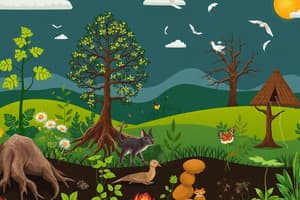Podcast
Questions and Answers
Which of the following is an example of a provisioning service in an ecosystem?
Which of the following is an example of a provisioning service in an ecosystem?
- Regulation of climate
- Production of food (correct)
- Pollination of plants
- Cultural heritage preservation
What is the primary difference between R-selected and K-selected species?
What is the primary difference between R-selected and K-selected species?
- R-selected species have longer lifespans
- R-selected species thrive in stable environments
- K-selected species invest more in parental care (correct)
- K-selected species produce many offspring
What impact does habitat fragmentation generally have on biodiversity?
What impact does habitat fragmentation generally have on biodiversity?
- It creates new habitats for specialist species
- It increases the overall population size of species
- It isolates populations, reducing genetic diversity (correct)
- It has no significant effect on species diversity
In the context of ecological succession, what typically characterizes a climax community?
In the context of ecological succession, what typically characterizes a climax community?
Which of the following describes a keystone species?
Which of the following describes a keystone species?
Which trophic level is primarily responsible for converting sunlight into chemical energy through photosynthesis?
Which trophic level is primarily responsible for converting sunlight into chemical energy through photosynthesis?
What is a characteristic feature of generalist species compared to specialist species?
What is a characteristic feature of generalist species compared to specialist species?
What effect do edge environments generally have on biodiversity?
What effect do edge environments generally have on biodiversity?
In the context of ecological succession, which term describes the initial species that colonize a barren environment?
In the context of ecological succession, which term describes the initial species that colonize a barren environment?
Which statement accurately describes the 10% rule in ecology?
Which statement accurately describes the 10% rule in ecology?
Flashcards
Carrying Capacity
Carrying Capacity
The maximum number of individuals of a species that an environment can support.
Ecosystem Services
Ecosystem Services
Benefits that humans derive from the environment.
Biodiversity
Biodiversity
The variety of life in a particular habitat or ecosystem.
Trophic Level
Trophic Level
Signup and view all the flashcards
Primary Succession
Primary Succession
Signup and view all the flashcards
Provisioning Services
Provisioning Services
Signup and view all the flashcards
Regulating Services
Regulating Services
Signup and view all the flashcards
Supporting Services
Supporting Services
Signup and view all the flashcards
Population Bottleneck
Population Bottleneck
Signup and view all the flashcards
Founders Effect
Founders Effect
Signup and view all the flashcards
Study Notes
Ecosystem Services
- Ecosystem services include provisioning, regulating, supporting, and cultural services
- Soil texture is a pyramid
- Soil horizons exist
- Carrying capacity is a concept
- Habitat fragmentation occurs
- Edge effect is a phenomenon
- Biodiversity includes genetic, species, and ecosystem diversity
Population Bottleneck and Founder Effect
- Population bottlenecks and founder effect are concepts in ecology
Terrestrial Biomes
- Taiga/Boreal Forest
- Temperate Rainforest
- Temperate Seasonal Forest
- Tropical Rainforest
- Shrubland/Woodland/Chaparral
- Temperate Grassland
- Savanna
- Tropical Seasonal Forest
- Desert
- Tundra
Species
- Generalist species exist
- Specialist species exist
- Invasive species are present
- Keystone species play a crucial role
- Trophic cascade is a concept
- Trophic levels exist
- Biomass is a measure
- 10% rule describes energy transfer
- Primary productivity is a measure
Primary Productivity
- Gross Primary Productivity
- Net Primary Productivity
Ecological Succession
- Primary succession
- Secondary succession
- Pioneer species are involved
- Climax community is the end result
Species Types
- R-selected species
- K-selected species
Survivorship Curves
- Type I survivorship curve
- Type II survivorship curve
- Type III survivorship curve
Feedback Loops
- Positive feedback loops
- Negative feedback loops
Studying That Suits You
Use AI to generate personalized quizzes and flashcards to suit your learning preferences.




